Most chickens are bred for their meat or egg production, with dual-purpose breeds satisfying these needs.
However, there are several breeds of ornamental chickens, and they are raised purely for show purposes.
In the United States, the American Poultry Association sets the standard for chicken breeds, so you know which qualities to look for in a show chicken.
Before choosing which chicken to show at your first exhibition, it is important to research the different show chicken breeds to know what to expect.
Keep reading our list of the top 20 best show chicken breeds to raise if you wish to enter your first chicken exhibition.
Table of Contents
ToggleSebright Bantam Chicken
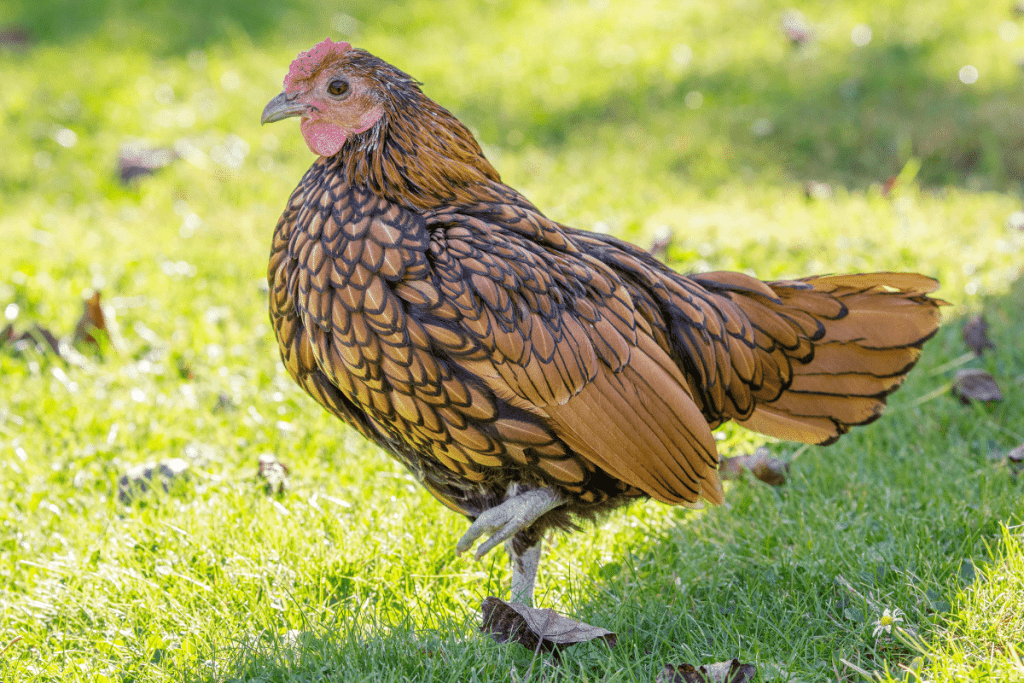
There are two varieties of the bantam Sebright chicken: the Silver Sebright and the Golden Sebright.
This breed of chicken was developed in England in the 1800s and was named after Sir John Sebright.
At a weight of around 22 ounces, the Sebright is one of the smallest bantam chicken breeds in the world.
The base color of the Sebright is usually either a silvery white or golden brown with dark black outlines on each of the feathers.
This contrast in colors gives the Sebright a stunning appearance.
Unlike some other chicken breeds, the hen and rooster share the same unique color pattern.
The Sebright is also known for having a purple-tinted comb, most commonly known as a Rose comb.
Old English Game Chicken
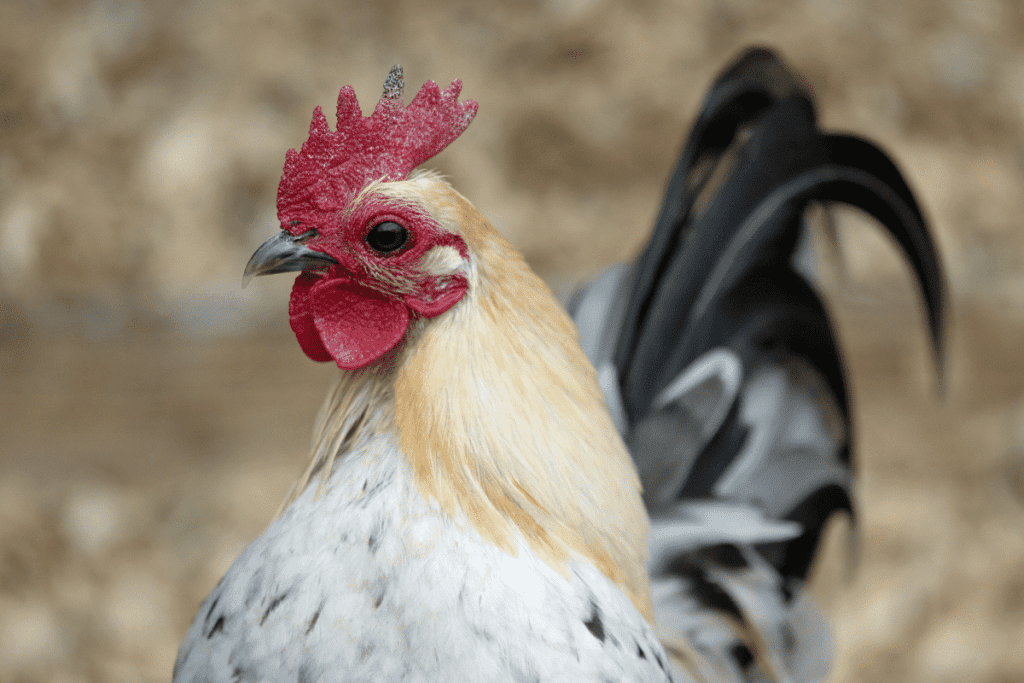
The Old English Game chicken originated in England, and it is one of the oldest chicken breeds in the world.
Very little is known about how this breed was developed, and it was mainly bred for use in cockfighting before the practice became illegal in most parts of the world.
Since the Old English Game chicken was bred for fighting, it is a fairly slender bird with a small comb and wattle.
This bird also tends to stand tall with its chests puffed out.
Standard Old English Game chickens weigh four to five pounds, and the smaller bantam versions weigh between 22-24 ounces.
The Old English Game chicken feathers are usually long and range in color from iridescent black to silvery white and golden brown.
The black feathers have dark green and purple shades, depending on the light.
Yokohama Show Chicken
The Yokohama show chicken was bred from the Shokoku and Shama Japanese chicken breeds.
However, despite its name, the Yokohama was developed in Germany.
The first breeding club for this Asian chicken breed was started in the United Kingdom, and this is where the bird gained popularity.
The Yokohama only weighs around 4 pounds, but its long tail feathers make it appear much larger.
Yokohama chickens come in various colors, including white, black, or blue with red shoulders, solid white, golden, silver, black buff, and spangled.
The Yokohama is one of the few breeds with extremely long tail feathers, setting it apart from other breeds.
Brahma Chicken
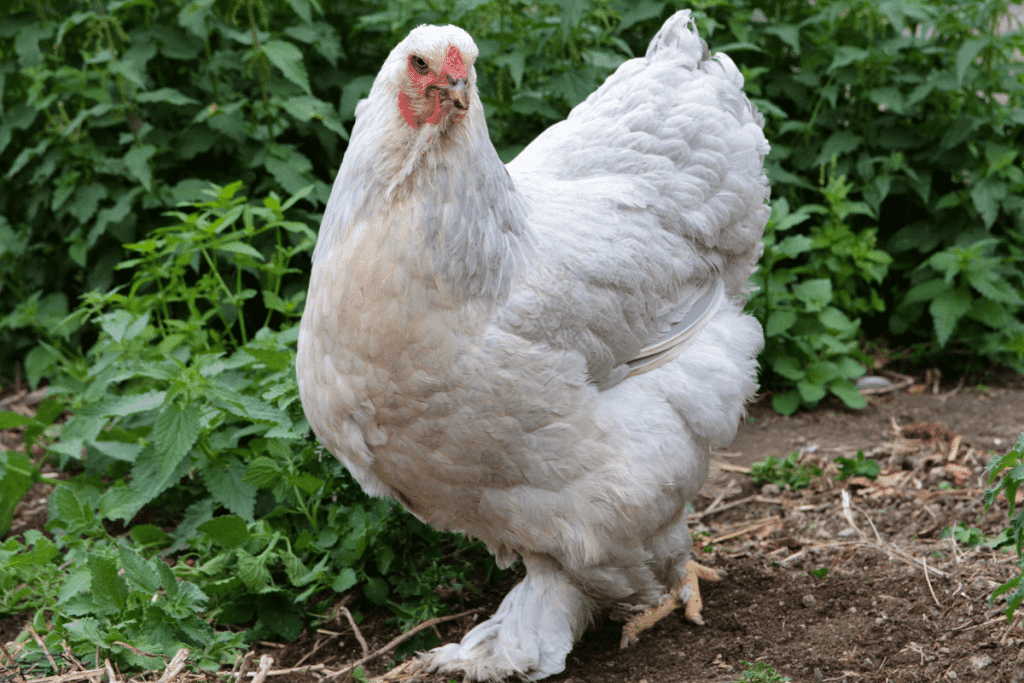
Not much is known about the Brahma chicken other than being developed in the United States sometime around 1850.
These beautiful birds were initially bred for their meat, resulting in a very large chicken weighing 5 to 10 pounds.
Since they are more commonly bred as show chickens, current Brahmas average around 8 pounds.
They have sturdy legs covered in dense feathering down to their toes.
The Brahma’s thick plumage comes in buff, dark, and light shades.
Each color of Brahma will have a contrasting color on its body.
For example, a light-colored Brahma will usually have dark feathers on the neck, wings, or tail.
Related: When do Brahma chickens mature?
Cochin Chicken
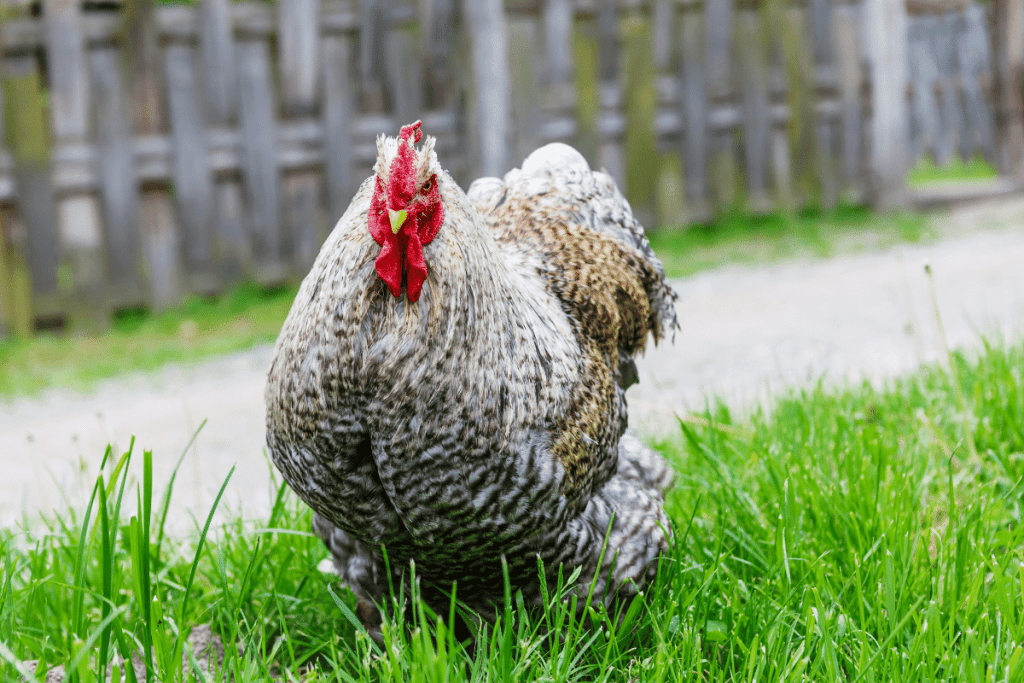
The Cochin chicken was developed in Vietnam in the mid-1800s.
While it was originally bred as an egg-layer, modern Cochins are bred solely for show purposes.
Like the Brahma, the Cochin is one of eight chicken breeds with feathered legs recognized by the American Poultry Association.
Cochins are among the biggest chicken breeds, weighing between 11-12 pounds, but they are rarely raised for meat due to their slow growth.
The Cochin comes in various colors, such as blue, red, buff, white, and black.
Their feather patterns range from barred, mottled, partridge, and golden or silver laced.
Faverolle Chicken
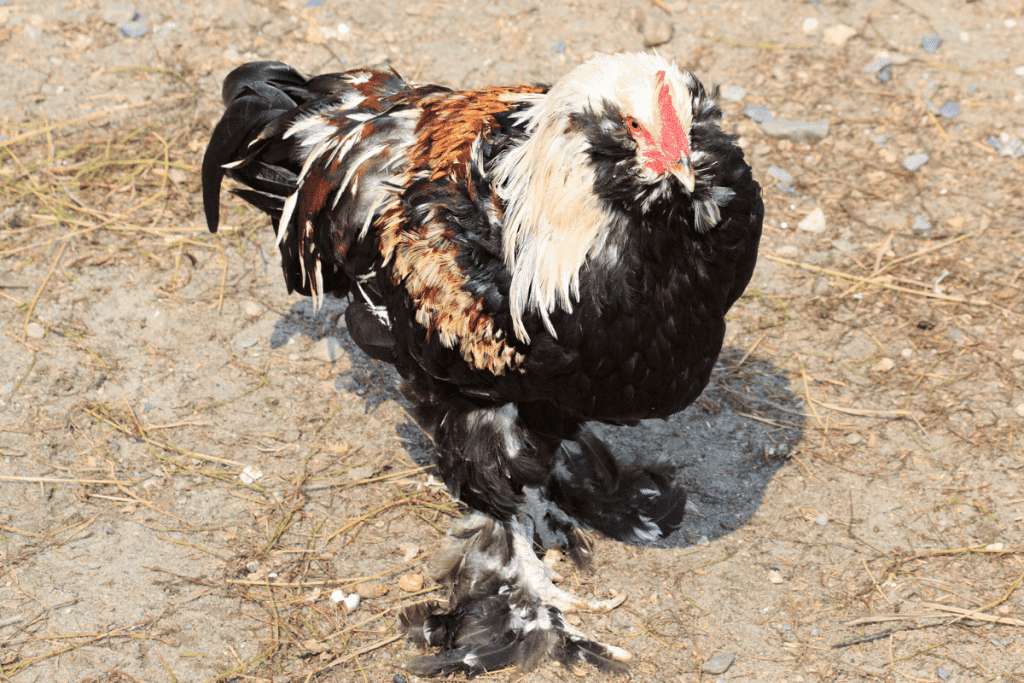
The Faverolle chicken originated in France, in the town of Faverolles, sometime in the 1800s.
It is thought to be a descendant of the Brahma, Houdan, and Dorking chicken breeds.
Faverolle chickens are very rare, and they are known as “the French poodle of chicken breeds.”
The Faverolle also has feathered legs and feet, but its most notable feature is its beard.
This breed weighs between 7.5-11 pounds, but it appears much larger due to its fluffy feathers.
The Faverolle chicken has five toes and comes in a variety of colors, including:
- Black
- Buff
- Laced blue
- Cuckoo
- Ermine
- Salmon
- White
The only color variations recognized by the American Poultry Association are the Salmon Faverolles and the White Faverolles.
Salmon Faverolle roosters and hens are different colors from each other.
The rooster has a black beard, muff, breast, thighs, under fluff, and tail.
These same areas on the hen are a creamy white color.
Orpington Chicken
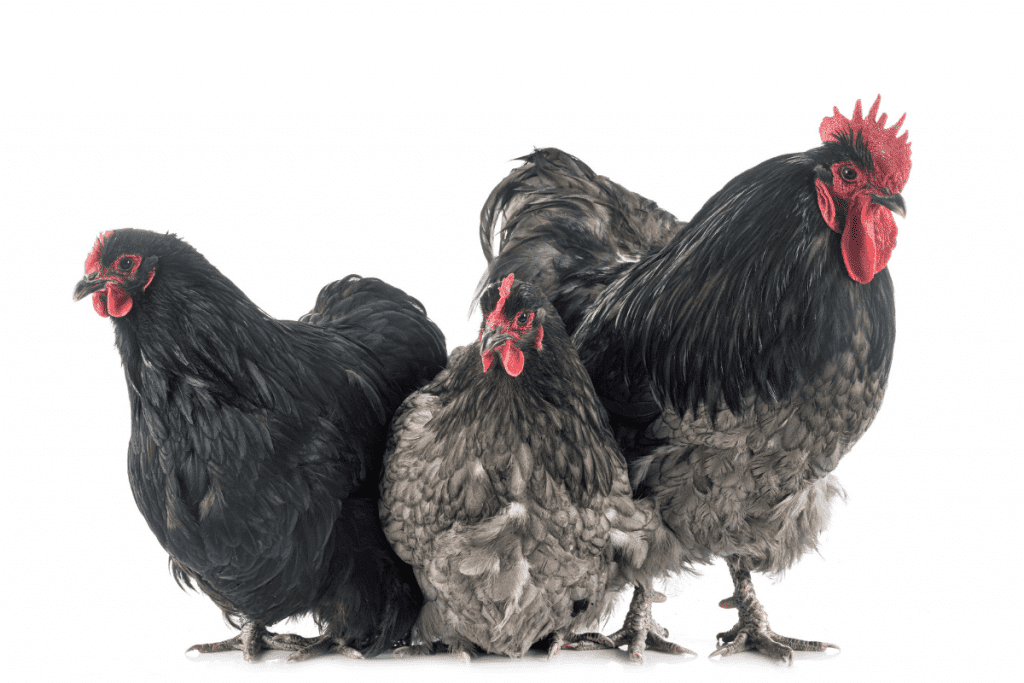
The Orpington chicken breed originated in the United Kingdom in the 1800s and was developed from the Minorca, Plymouth Rock, and Langshan chicken breeds.
The first Orpington chickens had black feathers, but buff and white feathered birds were eventually bred.
Black Orpingtons were first introduced in 1886, at the peak of the Industrial Revolution.
Since they were show birds, their black color was meant to hide any air pollutants which might stick to their feathers.
The white Orpington was developed in 1889, and the buff color was introduced in 1894.
The Orpington is a large bird, ranging from 8 to 10 pounds with fluffy feathers.
Modern-day Orpingtons may be black, buff, white, or blue.
Speaking of blue, check out our list of cool-looking blue chicken breeds.
Polish Chicken
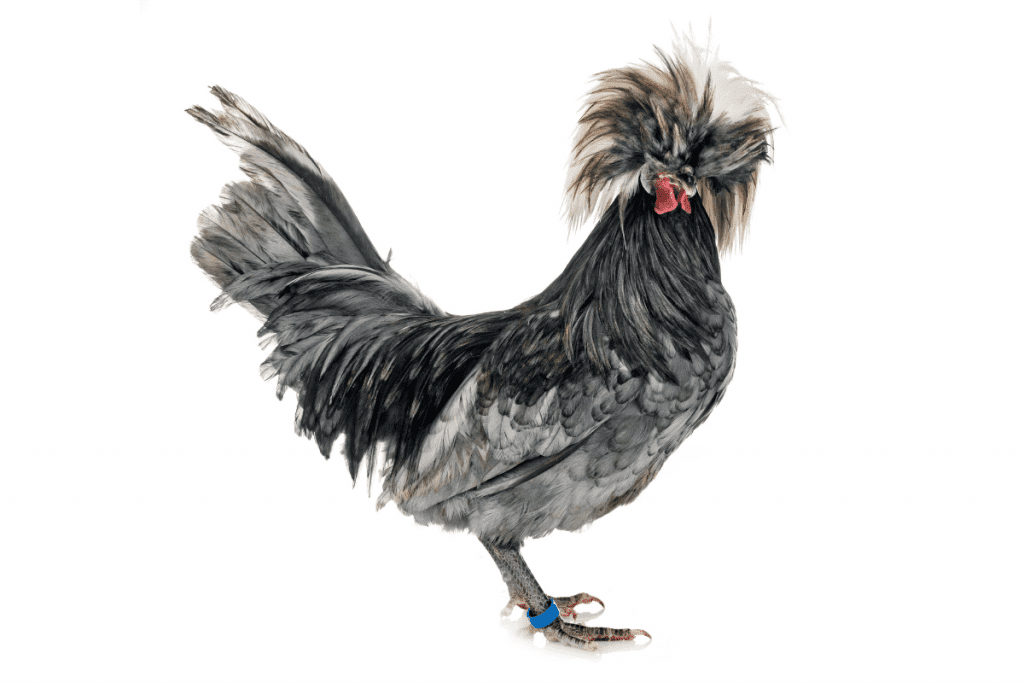
Despite its name, the Polish chicken breed originated in the Netherlands and was further developed in America between 1830 and 1840.
The breed gets its name from the feathers on its head resembling the headgear Polish warriors once wore.
Polish chickens are smaller birds, and they are well-known for the fluffy crest of feathers on their head.
They have small wattles, almost completely covered by their crest and beard feathers.
When they are not being shown, it is recommended to trim the crest feathers to prevent eye infections.
The body of a Polish chicken is usually black, with specks of white on the breast and crest.
Houdan Chicken
The Houdan chicken originated in France and is one of the oldest existing chicken breeds.
This ancient chicken breed has five toes instead of four, and they also have a fluffy crest of feathers on top of their head.
The Houdan is a smaller chicken with a weight range between 4 and 6 pounds.
The two main colors of Houdan chickens are black and white, and some are black with white specks, which is known as a mottled feather pattern.
For more black and white chickens, head over to our list.
Like the Polish chicken, the Houdan needs to have its crest trimmed regularly to prevent eye infections and aid in the animal’s vision.
Java Chicken
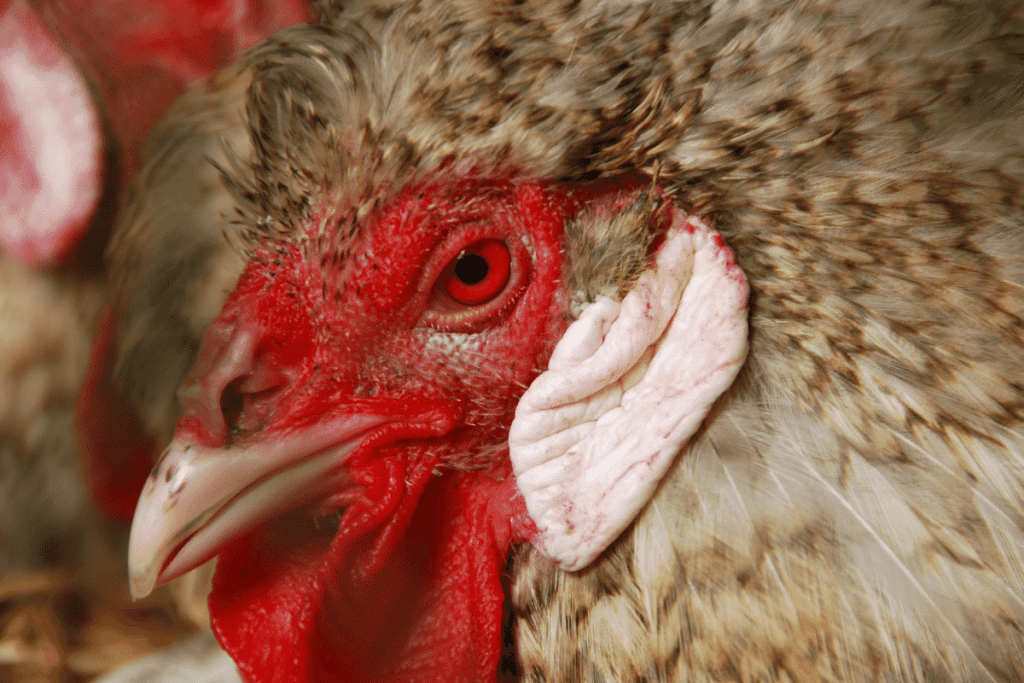
The Java chicken is an American heritage breed whose descendants come from the island of Java.
Java chickens are on the small side, with a 6.5-8 pounds weight range.
Java chickens come in black, white, auburn, and mottled color variations.
However, only the black and mottled Javas are recognized by the American Poultry Association.
The black feathers of a Java chicken have more of a green color to them than other black-feathered chicken breeds.
A mottled Java has black feathers with white specks.
The body of a Java chicken is rectangular with a sloping, long back.
Silkie Chicken
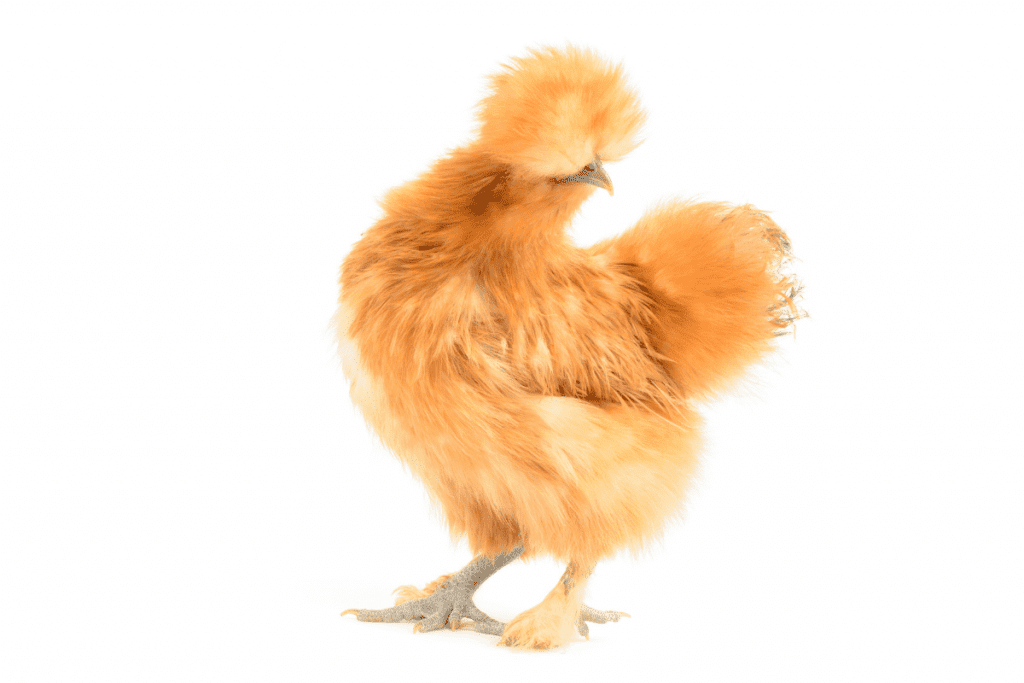
Silkies are small, bantam-sized chickens averaging 3-4 pounds, and their origins are not entirely known, but they are believed to come from China.
The unique look of a Silkie comes from its fluffy feathers, which resemble fur.
Silkies have feathers on their legs and usually have 1-2 extra toes on their feet due to a genetic mutation.
The Silkie chicken is one of the few breeds with a walnut comb type.
Silkies are either bearded or non-bearded and come in black, blue, buff, gray, partridge, or white colors.
Related: Why do silkie chickens have 5 toes?
Wyandotte Chicken
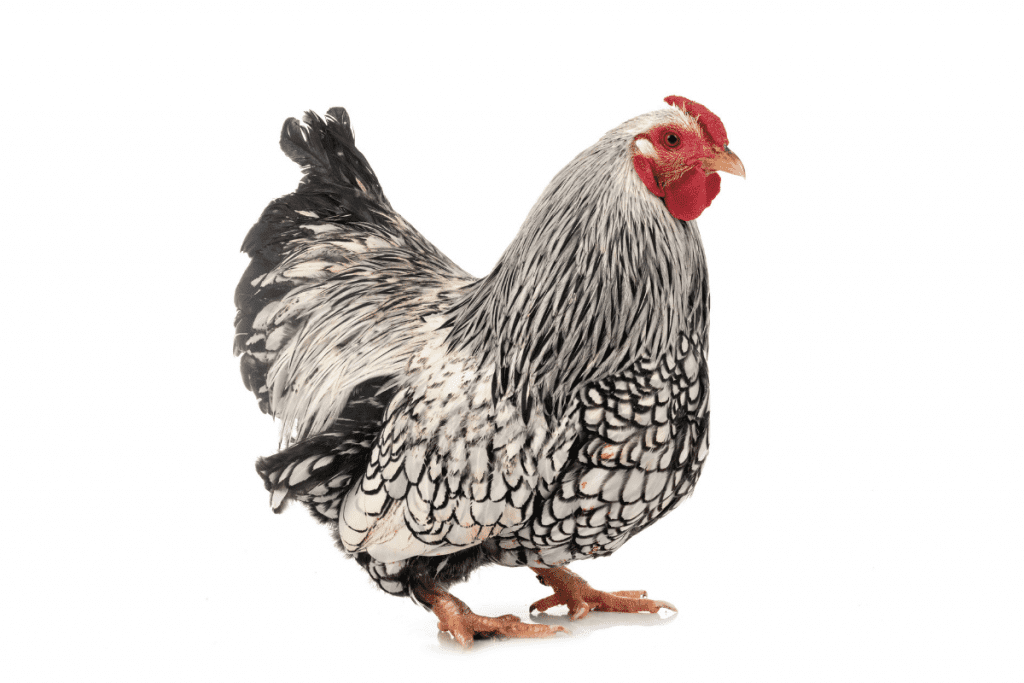
The Wyandotte was developed in America in the 1800s, and it was bred for its meat and egg production.
Wyandotte chickens are relatively large and weigh between 6.5-8.5 pounds.
The original color of this chicken breed is the Silver Laced Wyandotte.
Silver Laced Wyandottes are known for their silvery-white head and neck and a black stripe in the middle of every feather.
Wyandotte chickens have since been bred to come in a variety of colors and patterns, such as:
- Blue
- Black
- Buff
- White
- Partridge
- Columbian/Buff Columbian
- Silver/Gold Laced
- Silver Penciled
Like the Sebright chicken breed, the Wyandotte has a Rose comb.
Related: Wyandotte chicken growth rate
Buckeye Chicken
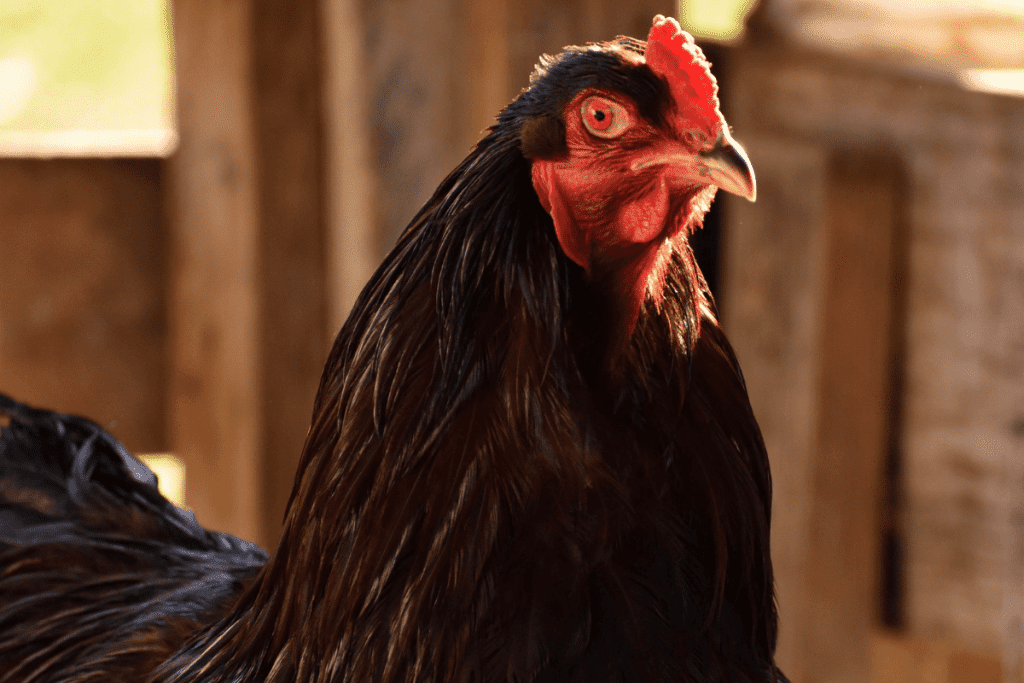
The Buckeye chicken was developed by Mrs. Nettie Metcalf in Warren, Ohio, sometime between 1890-1905.
Buckeye chickens were bred from the Barred Plymouth Rock, light Brahma, black Langshan, and buff Cochin chicken breeds.
The Buckeye is the only chicken bred in the United States to have a pea comb.
Buckeye chickens are fairly large, weighing between 6.5 and 9 pounds.
The only color of the Buckeye chicken is mahogany with a black tail.
Due to its lack of colorful feather patterns, the Buckeye is not shown as frequently as it used to be.
More info: How Long Do Buckeye Chickens Lay Eggs?
Modern Game Chicken
The Modern Game chicken is very similar to the Old English Game chicken, and it originated in England between 1850 and 1900.
The Modern Game chicken was developed by cross-breeding the Old English Game and Malay chickens.
It results in a very tall, upright bird with a slender body, and it was also initially bred for fighting.
Modern Game chickens only weigh between 4 and 5 pounds.
The Modern Game chicken comes in a dozen color varieties, but black, red, brown, duckwing, pyle, and birchen are the most common colors.
Modern Game chickens are strictly bred for show purposes since they produce very little meat or eggs.
Barbu d’Uccle Chicken
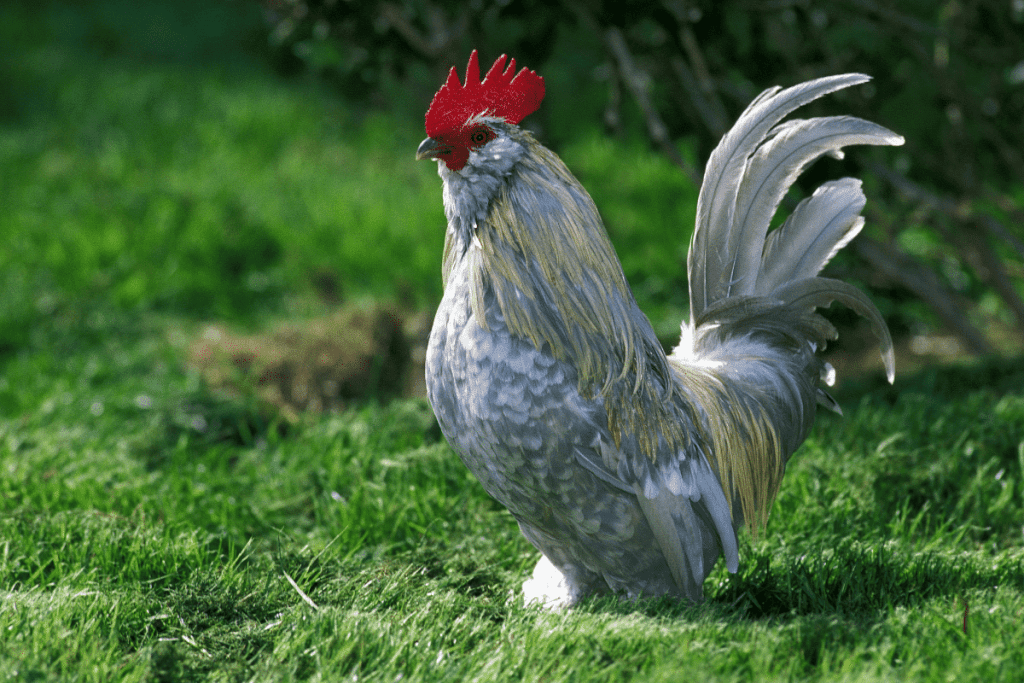
The Barbu d’Uccle chicken was developed in the 1890s in Belgium by cross-breeding the Antwerp Belgian, and Dutch booted bantam.
They are very small in size, weighing just 22-26 ounces, have a single comb, and are one of the few breeds to have feathered legs and feet.
The Barbu d’Uccle is raised strictly for show and comes in various colors, including lavender, blue, black, white, porcelain, and quail.
Dominique Chicken
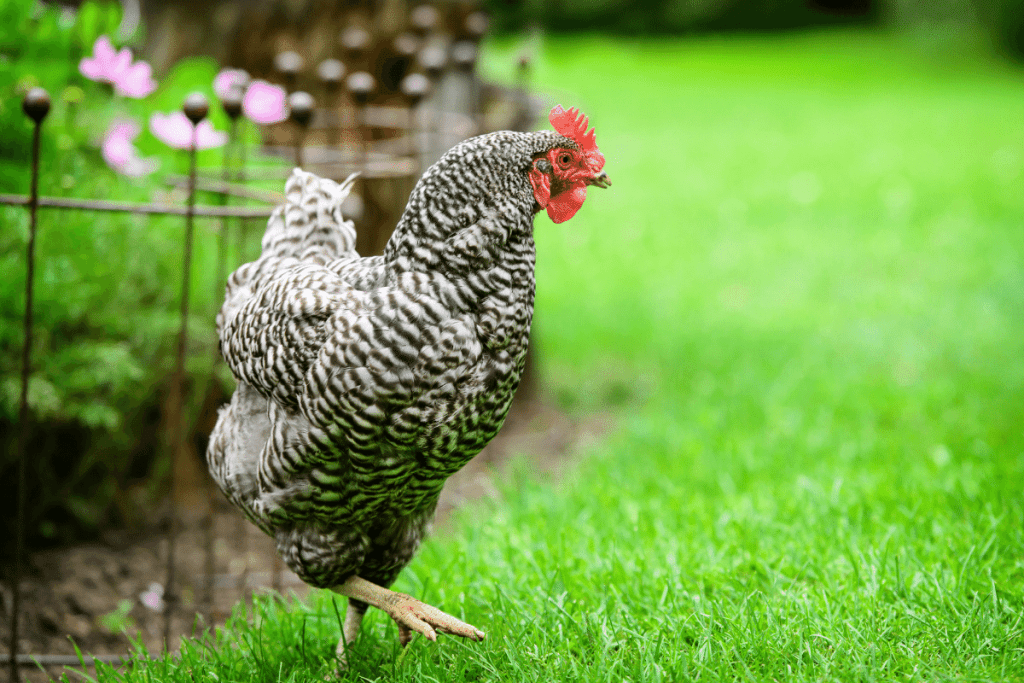
The Dominique is one of the oldest breeds of chickens in America, and it was brought to the United States by early settlers from England in the 1750s.
The breed gets its name from the French colony of St. Dominique, which is in Haiti.
A Dominique is also called the Pilgrim chicken.
The original Dominique chickens had both single combs and Rose combs, but the New York Poultry Society set the standard to be Rose combed.
Aside from the Rose comb, the main difference between the Barred Rock and the Dominique is the color pattern.
The Barred Rock breed will have a distinct, high-contrast, black and white barred pattern.
The Dominique has a more staggered barring pattern, and there is less contrast between the black and white feathers.
Rosecomb Bantam Chicken
The Rosecomb bantam chicken comes from England, and it gets its name from the Rose type of comb on its head.
The American Poultry Association officially recognized the breed in 1874.
Rosecomb Bantams are very small chickens, and they have large, erect tails, which makes them stand out from other breeds.
The Rosecomb is available in 25 different color varieties, but the American Poultry Association only recognizes blue, black, and white.
The most notable feature of the Rosecomb is its white earlobes, which stand out against the darker-colored birds.
Langshan Chicken
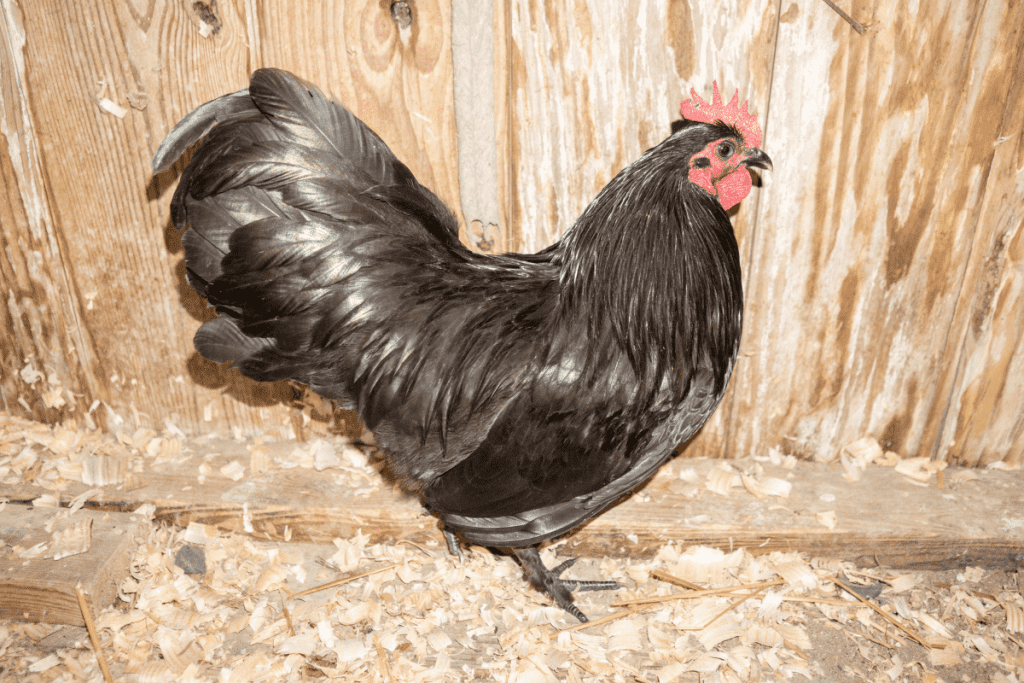
The Langshan chicken originated in China, and in 1872 it was brought to England for further development.
Major A.C. Croad of England was the first person known to import the breed.
The Langshan is a tall chicken and weighs between 7.5 and 9.5 pounds.
Langshan chickens have some feathers on their legs, but fewer than the Brahma or Cochin breeds.
Black Langshan chickens were the first to be recognized by the American Poultry Association in 1883, followed by White Langshans in 1893.
The APA did not recognize blue Langshans until 1987.
Malay Chicken
Malay chickens were first brought to England from India in 1830.
The American Poultry Association did not recognize the breed until 1883.
The Malay chicken is one of the tallest breeds, standing between 26″ and 36″ inches in height.
Malays have long, muscular bodies and weigh between 9-11 pounds.
The most common color combination of Malay chickens is black and red, but they are also available in white or tan varieties.
Its black feathers are iridescent, with a purple or green sheen to them.
The Malay’s comb and wattles are very small and close to the bird’s head.
Silver Phoenix Chicken
The Silver Phoenix chicken was originally bred in Japan and recognized by the American Poultry Association in 1965.
Silver Phoenix chickens are a very small breed, weighing between 4-5.5 pounds.
The most unique and striking feature of the Silver Phoenix is its extremely long tail feathers, known to be more than 20′ feet in length.
The plumage of the Silver Phoenix is black and white, with iridescent silver or blue accent feathers.
How useful was this post?
Click on a star to rate it!
We are sorry that this post was not useful for you!
Let us improve this post!
Tell us how we can improve this post?
